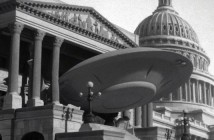Editor’s Note: This month marks the 30th Anniversary of Brazil. Feel free to share your memories of this film in the comments section below.
There is much to be said about Terry Gilliam’s epic dystopian masterpiece Brazil, not the least of which is the masterful way Gilliam tells the story of an imaginative man shackled by the machine of conformity. It’s also amazing that the film was made at all, considering the now-legendary amount of studio intervention that went so far as to create an entirely separate cut of the film that excises an hour of footage and does not let the story come out to its logical conclusion in favor of a happy ending. Gillam stood up to that pressure in unique ways and got his version of the film released (more on that later).
The story is that of Sam Lowery (Jonathan Price), a man content to be unrecognized at work, and who regularly refuses promotions arranged for by his rich and influential mother Ida (Katherine Helmond, best known for her role as Mona on TV’s Who’s the Boss?), who is always undergoing cosmetic surgeries to erase her age. Sam works at the Ministry of Information in the Records Department, largely known as a dead-end job. He’s happy there, plugging away and only really being recognized by his boss Mr. Kurtzmann (Ian Holm) for his abilities. One day, Sam stumbles upon an error in the system: the wrong man was apprehended and accused of terrorism. We know what happened because the opening sequence shows a fly dropping into the printer, causing a short and changing Tuttle to Buttle on one form and creating the confusion.
 Sam encountered the real terrorist, Harry Tuttle (Robert DeNiro), the previous night because his air conditioner went out and his call to Central Services was intercepted. Tuttle is a rogue heating engineer who broke away from Central Services because he hated the paperwork, and he had only gotten into heating and cooling for the excitement. This encounter and his realization of the mistake leads him to finally locate the woman he’s dreamed about for years. She is Jill Layton (Kim Greist) and she is the upstairs neighbor of the Buttles. Sam then risks anything and everything to meet her and be with her, which draws him into suspected terrorism and potential career suicide. He finds himself pitted against an indomitable system that encourages confession through torture, and even charges for your interrogation, and compels the torture victim to consider their credit rating before deciding to resist torture.
Sam encountered the real terrorist, Harry Tuttle (Robert DeNiro), the previous night because his air conditioner went out and his call to Central Services was intercepted. Tuttle is a rogue heating engineer who broke away from Central Services because he hated the paperwork, and he had only gotten into heating and cooling for the excitement. This encounter and his realization of the mistake leads him to finally locate the woman he’s dreamed about for years. She is Jill Layton (Kim Greist) and she is the upstairs neighbor of the Buttles. Sam then risks anything and everything to meet her and be with her, which draws him into suspected terrorism and potential career suicide. He finds himself pitted against an indomitable system that encourages confession through torture, and even charges for your interrogation, and compels the torture victim to consider their credit rating before deciding to resist torture.
Gilliam and his co-writers, playwright Tom Stoppard and Charles McKeown, created an impeccably scary version of the future, generically said to be “somewhere in the 20th century.” Brazil’s satire of government may ring truer to people in the U.K. because of the innumerable Ministries that are laid out in the film, and the frequent saying that the U.K. has a Ministry for everything — even Gilliam’s former comedy troupe Monty Python took a jab at U.K. Ministries with their “Ministry of Silly Walks” sketch — though its message is not lost on viewers elsewhere. The impenetrable bureaucracy the writers created is almost as terrifying as the torture or the random terrorist bombings. They also work in a believable, if convenient, love story that works with the story instead of against it. Also worked in are some amazingly designed dream sequences that show how far outside the norm Sam really is. All of these elements combine to make a funny, terrifying and brilliant dystopic fairy-tale.
Behind the camera, Gilliam has never been more assured. This film kicked off the most sustained and fruitful section of his directorial career, going from Brazil to The Adventures of Baron Munchausen, then his other masterpiece The Fisher King, and finally 12 Monkeys. These four films represent Gilliam’s best work because they are his most fulfilled and satisfying works. Later, his films would become wildly unfocused and at times relentlessly bleak and/or unpleasant. What he does with Brazil visually is remarkable. Using a long lens at close range, he creates a kind of bowed edge to the frame that skews the vision of the audience, making us constantly aware of something odd going on but unable to fully place it. it’s not quite a fish-eye effect, but it’s close and it gives the film a feeling of unease. He combines this camera technique with some of the most impressive production/set design of the 1980’s, or indeed ever, courtesy Norman Garwood, John Beard and Keith Pain. By showing unreliable mechanics, ducts and wires everywhere and the rows of people on typewriter-computer hybrids, Gilliam gives us a future reliant on unreliable technology and gives everything an imposing and claustrophobic air.
This atmosphere is in direct contrast to Sam’s dreams where he is flying on an Icarus-inspired winged backpack, soaring through beautifully clouded airs and doing battle with the forces that seek to restrain him and his love. Gilliam lets these sequences breathe and gives the audience a chance to recuperate after the dull grayness and stifling nature of the film’s real world. These dream sequences also set Sam apart from that world, showing that he has the capacity for imagination, something that seems to have been squelched from the rest of that society. Gilliam’s visual aesthetics are utterly unique and serve the story brilliantly as we move through the film and root for the people that have been trying to upend the restrictive nature of this society for 13 years (as we learn from a TV interview).
The only false move Gilliam makes, and it is a minor one, is that the film feels like it has wound up when there is still nearly an hour left. The picture picks up the pace not long after, but there is a slow patch of about fifteen minutes that one wonders how there can still be more film when the core story feels resolved. We quickly learn it isn’t, but it just drags in the middle and it grinds the film to a momentary halt. This is remedied soon after and that slow spot is all but forgotten, but it should be noted nevertheless.
The dispute over the film that was brought up at the beginning of this article is almost as interesting as the film itself. Fearing Gilliam’s wacked-out vision for the film, the studio recut the film from 142 minutes to around 90, altering the ending completely and fully believing that their version would be more accessible to audiences. Gilliam didn’t take kindly to this butchering of his film (and it is a vastly inferior cut, which is available in the Criterion Collection edition of the film so the comparison can be made), so while promoting the film through a series of lectures, he was allowed by the studio to show only clips of the film. He took that to the extreme and decided to show the entire film, claiming it was just one long clip. Having his version seen by these lecture participants generated word of mouth and a letter campaign that led to the release of the full version, relegating the studio’s cut to television and eventually obscurity.
Brazil stands today as Gilliam’s best realized film and first masterpiece, paving the way for his second masterpiece, the somewhat similarly themed (though radically different) The Fisher King. Throughout his career, his imagination and committal to his vision has rendered him with a somewhat notorious reputation within the industry. He has struggled to make every one of his films because of his vision and his refusal to compromise that vision. With Brazil, he proved that audiences were able to understand his fantasy and that his vision could be accepted on a wider level. It didn’t make getting his films made without intervention any easier, but it did allow him some latitude and established him as a directorial force to be reckoned with. Brazil is one of those films that just stays with you long after you’ve seen it, and every time something new pops up that thrills and delights. Now, 30 years after its release, Brazil can safely be put into the canon of great films for just that reason.



